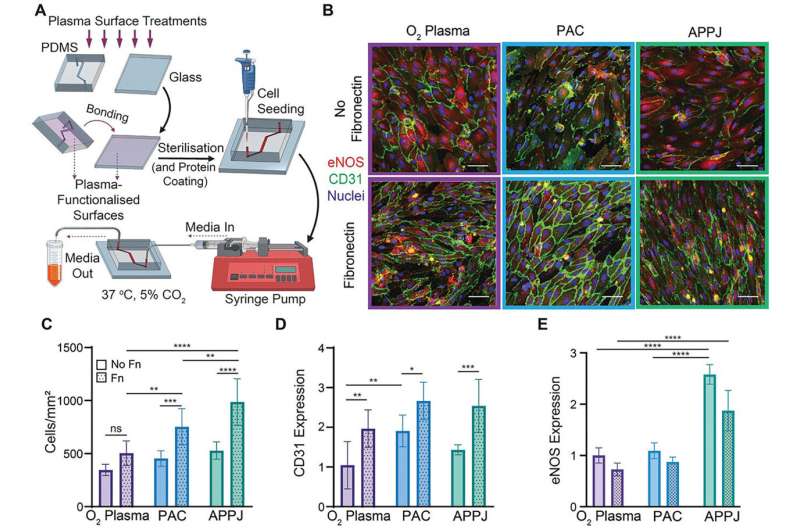This article has been reviewed according to Science X's editorial process and policies. Editors have highlighted the following attributes while ensuring the content's credibility:
fact-checked
peer-reviewed publication
trusted source
proofread
New transparent 'blood vessel-on-a-chip' could reduce animal testing

Researchers have developed a "blood vessel-on-a-chip" for heart disease with the potential to change the future of drug testing and development. The technology could also reduce our reliance on animal testing.
The University of Sydney team successfully created a transparent microchip with the potential to reduce the testing of new drugs to treat heart disease on animals before proceeding to clinical trials.
The innovative device mimics blood vessel damage due to high blood flow and inflammation, the first stage that leads to development of heart disease. The design offers a more accurate and detailed understanding of how and why blockages occur in specific locations in blood vessels. The development of the technology has been published in two journal articles.
"This is an incredible development because we took advantage of these microchips being made from a transparent material, and we mimicked the conditions of the coronary artery, that supplies blood to the heart muscle, and imaged them with a microscope to map the areas of cell damage which were similar to the locations of blockages in patients with heart disease," says Associate Professor Anna Waterhouse from the Charles Perkins Center and the Sydney Nano Institute.
"If we use an animal model, we are unable to see changes at this level of detail in a living organism because you can't see through the vessels."
Responsible for over 18 million deaths annually, cardiovascular disease is the leading cause of mortality globally and a major public health concern.
The first study, published in Advanced Functional Materials and led by Associate Professor Waterhouse who is also from the School of Medical Sciences, Faculty of Medicine and Health, outlines the development of the "blood vessel-on-a-chip."
A blood vessel-on-a-chip is a small device that has tiny channels etched into it where human cells can grow, mimicking the structure and function of human blood vessels which helps scientists and doctors do tests quickly and with very little liquid.
Although mice and other animals have similarities to human biology, the vessel-on-a-chip utilizes real human cells and offers more manageable and cost-effective control in the lab.
"Innovations like this in the field of organ-on-a-chip technology are crucial for potentially benefiting millions worldwide, offering faster and more cost-effective development of drugs without relying on animal testing," says Associate Professor Waterhouse
In a second study they teamed up with Professor Marcela Bilek from the School of Biomedical Engineering and the School of Physics.
This study, published in Advanced Materials Technologies and co-led by Professor Bilek and Professor Waterhouse, developed a new more effective surface modification approach that improves the materials current microchips are made from, making them better for protein and cells to attach to compared to the traditional materials.
Professor Bilek, also from the Drug Discovery Initiative, the Sydney Nano Institute and the Charles Perkins Center said, "Our invention revolutionizes the field of microchips, offering better surface properties in the chip compared to traditional devices.
"We've made the process of developing a microchip more efficient without compromising results, aiming to reduce the need for animal testing.
"The new method is more effective at bonding the surface coating more tightly and binding biomolecules for cells to grow on, which is essential to mimic blood flow through the devices."
The researchers hope that with the findings from the two studies, the microchip developed can be used in the biomedical space for modeling human organs and diseases. This would provide a better understanding of human biology and the outcomes of drug screening.
"We want to further our research by testing devices that simulate complex interactions within human organs, enabling us to replicate more advanced disease stages, such as severe heart disease or advanced cancer," said Associate Professor Waterhouse.
The teams are now working to incorporate additional types of vascular cells to better mimic human vessels and add in fats to mimic the build-up of cholesterol in blood vessel cells, which is the next stage of heart disease.
They are also developing the patented surface modification technique to apply it to sensors and diagnostics.
More information: Deepu Ashok et al, Reagent‐Free Covalent Immobilization of Biomolecules in a Microfluidic Organ‐On‐A‐Chip, Advanced Functional Materials (2024). DOI: 10.1002/adfm.202313664
Jasneil Singh et al, Spatiotemporally Mapped Endothelial Dysfunction at Bifurcations in a Coronary Artery‐on‐a‐Chip, Advanced Materials Technologies (2024). DOI: 10.1002/admt.202301596



















